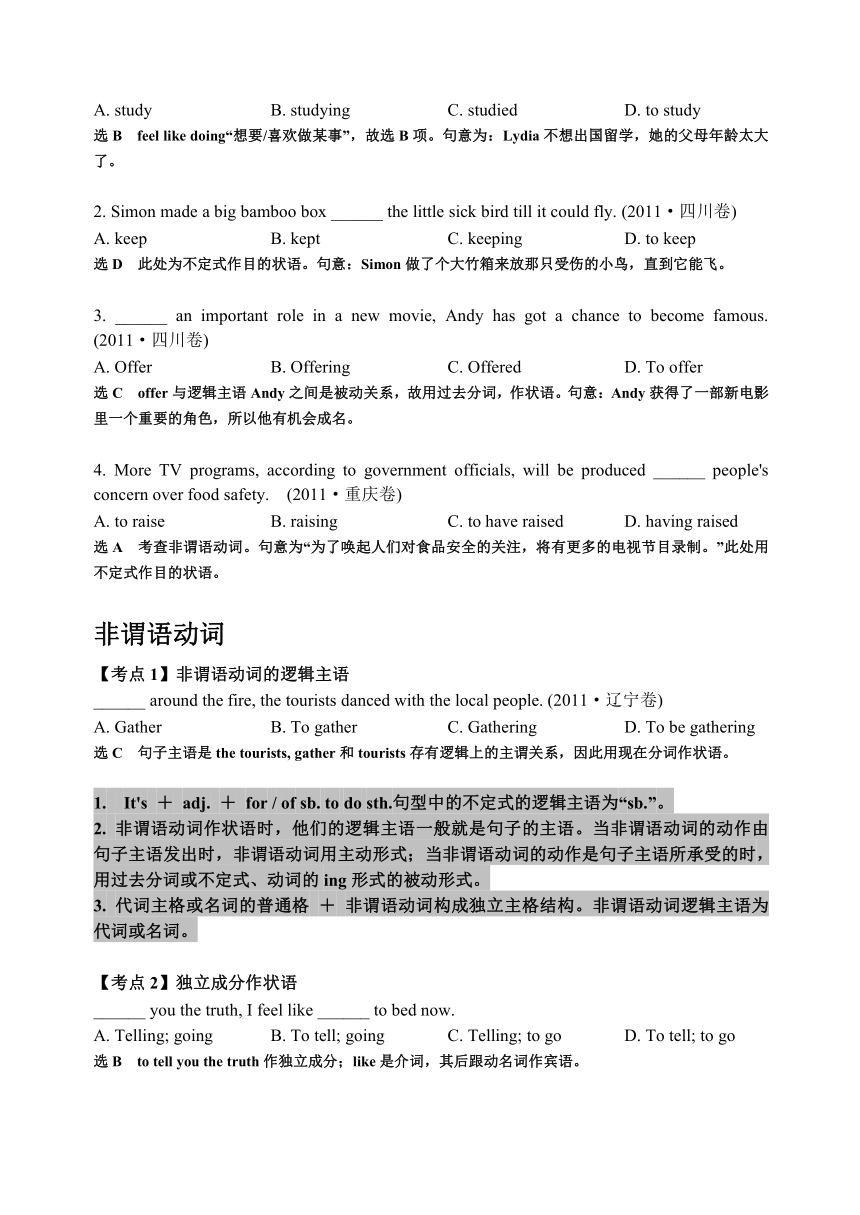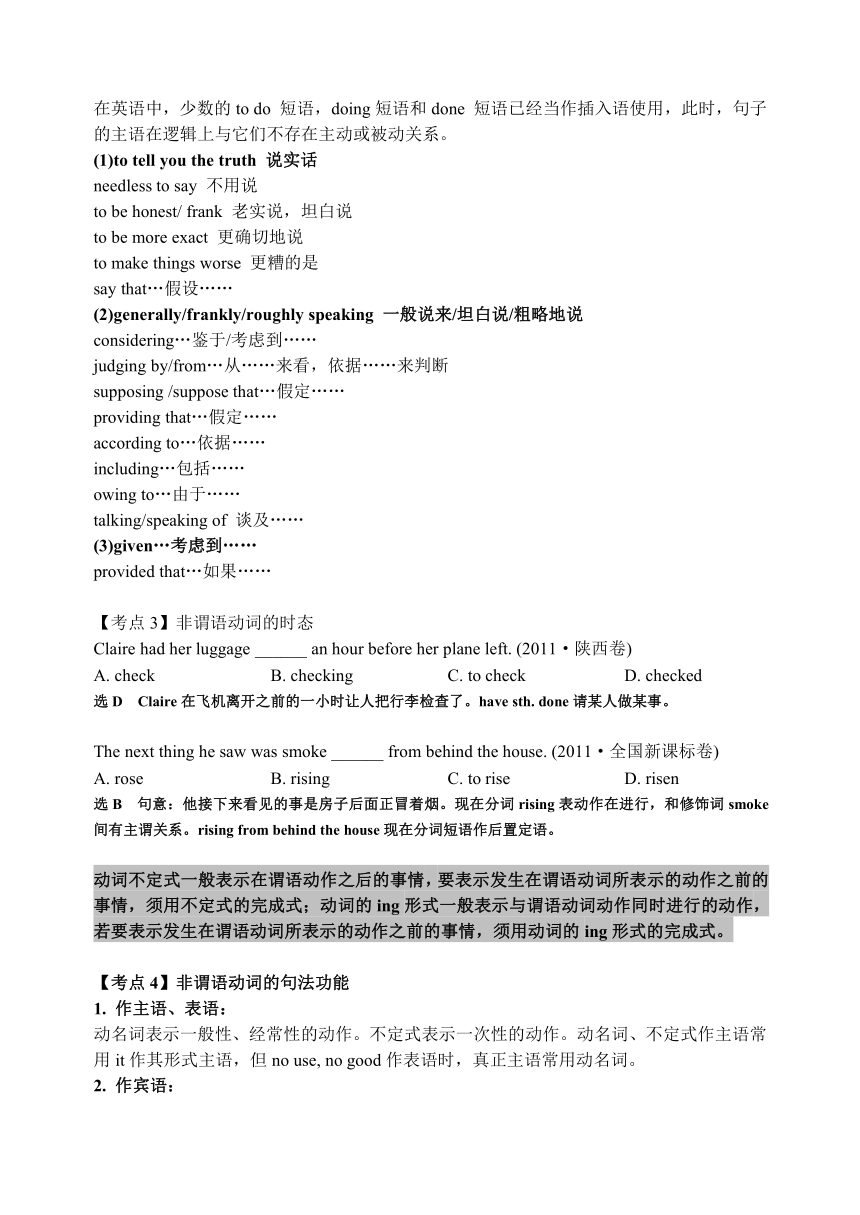2013高考英语语法专项复习:非谓语动词与with复合结构
文档属性
| 名称 | 2013高考英语语法专项复习:非谓语动词与with复合结构 |  | |
| 格式 | zip | ||
| 文件大小 | 20.6KB | ||
| 资源类型 | 教案 | ||
| 版本资源 | 牛津译林版 | ||
| 科目 | 英语 | ||
| 更新时间 | 2013-01-14 07:31:08 | ||
图片预览



文档简介
单项填空
第9课时 非谓语动词与with复合结构
1. Lydia doesn't feel like ______ abroad. Her parents are old. (2011·四川卷)
A. study
B. studying
C. studied
D. to study
选B feel like doing“想要/喜欢做某事”,故选B项。句意为:Lydia不想出国留学,她的父母年龄太大了。
2. Simon made a big bamboo box ______ the little sick bird till it could fly. (2011·四川卷)
A. keep
B. kept
C. keeping
D. to keep
选D 此处为不定式作目的状语。句意:Simon做了个大竹箱来放那只受伤的小鸟,直到它能飞。
3. ______ an important role in a new movie, Andy has got a chance to become famous. (2011·四川卷)
A. Offer
B. Offering
C. Offered
D. To offer
选C offer与逻辑主语Andy之间是被动关系,故用过去分词,作状语。句意:Andy获得了一部新电影里一个重要的角色,所以他有机会成名。
4. More TV programs, according to government officials, will be produced ______ people's concern over food safety. (2011·重庆卷)
A. to raise
B. raising
C. to have raised
D. having raised
选A 考查非谓语动词。句意为“为了唤起人们对食品安全的关注,将有更多的电视节目录制。”此处用不定式作目的状语。
非谓语动词
【考点1】非谓语动词的逻辑主语
______ around the fire, the tourists danced with the local people. (2011·辽宁卷)
A. Gather
B. To gather
C. Gathering
D. To be gathering
选C 句子主语是the tourists, gather和tourists存有逻辑上的主谓关系,因此用现在分词作状语。
1. It's + adj. + for / of sb. to do sth.句型中的不定式的逻辑主语为“sb.”。
2. 非谓语动词作状语时,他们的逻辑主语一般就是句子的主语。当非谓语动词的动作由句子主语发出时,非谓语动词用主动形式;当非谓语动词的动作是句子主语所承受的时,用过去分词或不定式、动词的 ing形式的被动形式。
3. 代词主格或名词的普通格 + 非谓语动词构成独立主格结构。非谓语动词逻辑主语为代词或名词。
【考点2】独立成分作状语
______ you the truth, I feel like ______ to bed now.
A. Telling; going
B. To tell; going
C. Telling; to go
D. To tell; to go
选B to tell you the truth作独立成分;like是介词,其后跟动名词作宾语。
在英语中,少数的to do 短语,doing短语和done 短语已经当作插入语使用,此时,句子的主语在逻辑上与它们不存在主动或被动关系。
(1)to tell you the truth 说实话
needless to say 不用说
to be honest/ frank 老实说,坦白说
to be more exact 更确切地说
to make things worse 更糟的是
say that…假设……
(2)generally/frankly/roughly speaking 一般说来/坦白说/粗略地说
considering…鉴于/考虑到……
judging by/from…从……来看,依据……来判断
supposing /suppose that…假定……
providing that…假定……
according to…依据……
including…包括……
owing to…由于……
talking/speaking of 谈及……
(3)given…考虑到……
provided that…如果……
【考点3】非谓语动词的时态
Claire had her luggage ______ an hour before her plane left. (2011·陕西卷)
A. check
B. checking
C. to check
D. checked
选D Claire在飞机离开之前的一小时让人把行李检查了。have sth. done请某人做某事。
The next thing he saw was smoke ______ from behind the house. (2011·全国新课标卷)
A. rose
B. rising
C. to rise
D. risen
选B 句意:他接下来看见的事是房子后面正冒着烟。现在分词rising表动作在进行,和修饰词smoke间有主谓关系。rising from behind the house现在分词短语作后置定语。
动词不定式一般表示在谓语动作之后的事情,要表示发生在谓语动词所表示的动作之前的事情,须用不定式的完成式;动词的 ing形式一般表示与谓语动词动作同时进行的动作,若要表示发生在谓语动词所表示的动作之前的事情,须用动词的 ing形式的完成式。
【考点4】非谓语动词的句法功能
1. 作主语、表语:
动名词表示一般性、经常性的动作。不定式表示一次性的动作。动名词、不定式作主语常用it作其形式主语,但no use, no good作表语时,真正主语常用动名词。
2. 作宾语:
(1)有些动词只跟动名词作宾语
常用的这类动词有: mind, finish, enjoy, excuse, imagine, keep, practice, suggest, miss, consider, prevent, appreciate, advise, avoid, allow, admit, delay, escape, permit, forbid等。
(2)有些动词只跟不定式作宾语
常用的这类动词有: want, wish, hope, expect, agree, decide, learn, pretend, ask, promise, plan, refuse, beg, demand, manage, offer, prepare, claim, struggle等。
(3)remember, forget, regret后接动名词和不定式的区别:后接动名词表示先于谓语动词的动作;后接不定式表示后于谓语动词的动作。
(4)want, need, require和deserve后接动名词和不定式的用法:当它们后面所接的动词与句子的主语是动宾关系时,用动名词的主动式或不定式的被动式。
(5)在try, stop, mean, go on, can't help后,用动名词和不定式所表达的含义不同,要注意:
can't help doing sth. 情不自禁做某事;can't help (to) do sth. 不能帮助做某事
3. 作宾语补足语:
Michael put up a picture of Yao Ming beside the bed to keep himself ______ of his own dreams. (2011·重庆卷)
A. reminding
B. to remind
C. reminded
D. remind
选C keep oneself reminded of his own dreams。过去分词 reminded作宾补。
Even the best writers sometimes find themselves ______ for words. (2011·浙江卷)
A. lose
B. lost
C. to lose
D. having lost
B 可以从lost for words (欲言又止;迷失语言)这一习语来理解。此题易误选C,考生可能会将find sb. to do跟find oneself(to be)done混淆。根据句意可知谓语动词是find“发现”,“即使最好的作家有时也会发现自己……”,作宾补的四个选项围绕lose变化。动词lose的基本含义是“丢失”,引申义是“使……沉溺于”(使动用法容易被考生忽略),跟逻辑主语themselves的关系是被动。
熟悉并掌握哪些动词或短语如advise, allow, like, wish, want, help等须接不定式作宾语补足语;哪些动词或短语如find, suggest, lead to等可接动词的 ing形式作宾语补足语;哪些动词或短语如feel, see, watch, hear, have 等既可接动词的 ing形式又可接过去分词作宾语补足语;何时用主动形式作宾语补足语,何时用被动形式或过去分词作宾语补足语,一般由非谓语动词与宾语的关系确定。
4. 作定语:
On receiving a phone call from his wife ______ she had a fall, Mr. Gordon immediately rushed home from his office. (2011·江西卷)
A. says
B. said
C. saying
D. to say
选C saying作后置定语修饰a phone call from his wife “来自他妻子的一个电话说”。
Tsinghua University, ______ in 1911, is home to a great number of outstanding figures. (2011·福建卷)
A. found
B. founding
C. founded
D. to be founded
选C 清华大学成立于1911年。过去分词founded 作非限制性定语修饰Tsinghua University(清华大学)。
(1) 注意非谓语动词的形式,不定式作定语一般用主动式,只有当不定式的逻辑主语不是句子的主语或宾语时,才用被动式;现在分词作定语表示主动意义,动作正在进行;过去分词一般表示被动、完成含义。
(2) 非谓语动词的位置:非谓语动词短语作定语时,都要放在所修饰的词之后;单个的动词的 ing形式或过去分词作定语时,一般放在所修饰的词之前。
不及物动词的不定式作定语,与修饰的名词构成动宾关系时,不及物动词后面的介词不能丢。
5. 不定式与现在分词作结果状语的区别:
不定式、现在分词都能表示结果,其区别是:不定式一般表示出乎意料的结果,不定式前常用only修饰;而动词的-ing形式表示自然或必然的结果。
More highways have been built in China, ______ it much easier for people to travel from one place to another. (2011·陕西卷)
A. making
B. made
C. to make
D. having made
选A 句意:在中国更多的公路已被修建,这样使得人们从一个地方旅游到另一个地方更为容易。making分词短语表意料之中的结果。若是only to make则表示意料之外的结果。
【考点5】不定式to的省略
1. 动词see, watch, hear, feel, notice, observe, look at, listen to, let, have, make 接不定式作宾补时,不定式的to须省略,但句子变为被动语态时,不定式的to不能省略。
2. why, would rather, had better, may as well, cannot (help / choose) but等后须跟省to的不定式。
3. 介词but, except等前若有行为动词do, 其后常用省to的不定式作宾语;若没有行为动词do, 则用带to的不定式。
4. 不定式作表语时,若主语中有行为动词do 的某一形式时,不定式的to可有可无。
With 复合结构
With his mother ______ him, he is getting on well with his work.
A. help
B. to help
C. helping
D. helped
选C 这是with的复合结构, his mother与help是逻辑上的主谓关系,所以排除D, 如选B则有将来的意思,显然不合语境,选C表示“他妈一直在帮他”, 正合句意。
It was a pity that the famous painter died ______ his painting unfinished.
A. of
B. from
C. out
D. with
本题考查with复合结构充当状语的用法,不是词组die of…, die from…和die out。
with 复合结构在句中一般作状语和定语,常见形式有:
1.“with+名词/代词+介词短语”。
The man was walking on the street, with a book under his arm.
2. “with+名词/代词+形容词”。
He likes to sleep with the door open.
3. “with+名词/代词+副词”。
The square looks more beautiful with all the lights on.
4. “with+名词/代词+名词”。
He left home, with his wife a hopeless soul.
5. “with+名词/代词+done”。在此结构中,过去分词和宾语是被动关系,表示动作已经完成。
With the problem solved, he went out to play.
6. “with+名词/代词+ ing分词”。此结构强调名词是 ing分词的动作的发出者或某动作、状态正在进行。
He felt more uneasy with the whole class staring at him.
7. “with+宾语+to do”。此结构中,不定式和宾语是被动关系,表示尚未发生的动作。
With nothing to do, I'll go out for a walk in the park.
第9课时 非谓语动词与with复合结构
1. Lydia doesn't feel like ______ abroad. Her parents are old. (2011·四川卷)
A. study
B. studying
C. studied
D. to study
选B feel like doing“想要/喜欢做某事”,故选B项。句意为:Lydia不想出国留学,她的父母年龄太大了。
2. Simon made a big bamboo box ______ the little sick bird till it could fly. (2011·四川卷)
A. keep
B. kept
C. keeping
D. to keep
选D 此处为不定式作目的状语。句意:Simon做了个大竹箱来放那只受伤的小鸟,直到它能飞。
3. ______ an important role in a new movie, Andy has got a chance to become famous. (2011·四川卷)
A. Offer
B. Offering
C. Offered
D. To offer
选C offer与逻辑主语Andy之间是被动关系,故用过去分词,作状语。句意:Andy获得了一部新电影里一个重要的角色,所以他有机会成名。
4. More TV programs, according to government officials, will be produced ______ people's concern over food safety. (2011·重庆卷)
A. to raise
B. raising
C. to have raised
D. having raised
选A 考查非谓语动词。句意为“为了唤起人们对食品安全的关注,将有更多的电视节目录制。”此处用不定式作目的状语。
非谓语动词
【考点1】非谓语动词的逻辑主语
______ around the fire, the tourists danced with the local people. (2011·辽宁卷)
A. Gather
B. To gather
C. Gathering
D. To be gathering
选C 句子主语是the tourists, gather和tourists存有逻辑上的主谓关系,因此用现在分词作状语。
1. It's + adj. + for / of sb. to do sth.句型中的不定式的逻辑主语为“sb.”。
2. 非谓语动词作状语时,他们的逻辑主语一般就是句子的主语。当非谓语动词的动作由句子主语发出时,非谓语动词用主动形式;当非谓语动词的动作是句子主语所承受的时,用过去分词或不定式、动词的 ing形式的被动形式。
3. 代词主格或名词的普通格 + 非谓语动词构成独立主格结构。非谓语动词逻辑主语为代词或名词。
【考点2】独立成分作状语
______ you the truth, I feel like ______ to bed now.
A. Telling; going
B. To tell; going
C. Telling; to go
D. To tell; to go
选B to tell you the truth作独立成分;like是介词,其后跟动名词作宾语。
在英语中,少数的to do 短语,doing短语和done 短语已经当作插入语使用,此时,句子的主语在逻辑上与它们不存在主动或被动关系。
(1)to tell you the truth 说实话
needless to say 不用说
to be honest/ frank 老实说,坦白说
to be more exact 更确切地说
to make things worse 更糟的是
say that…假设……
(2)generally/frankly/roughly speaking 一般说来/坦白说/粗略地说
considering…鉴于/考虑到……
judging by/from…从……来看,依据……来判断
supposing /suppose that…假定……
providing that…假定……
according to…依据……
including…包括……
owing to…由于……
talking/speaking of 谈及……
(3)given…考虑到……
provided that…如果……
【考点3】非谓语动词的时态
Claire had her luggage ______ an hour before her plane left. (2011·陕西卷)
A. check
B. checking
C. to check
D. checked
选D Claire在飞机离开之前的一小时让人把行李检查了。have sth. done请某人做某事。
The next thing he saw was smoke ______ from behind the house. (2011·全国新课标卷)
A. rose
B. rising
C. to rise
D. risen
选B 句意:他接下来看见的事是房子后面正冒着烟。现在分词rising表动作在进行,和修饰词smoke间有主谓关系。rising from behind the house现在分词短语作后置定语。
动词不定式一般表示在谓语动作之后的事情,要表示发生在谓语动词所表示的动作之前的事情,须用不定式的完成式;动词的 ing形式一般表示与谓语动词动作同时进行的动作,若要表示发生在谓语动词所表示的动作之前的事情,须用动词的 ing形式的完成式。
【考点4】非谓语动词的句法功能
1. 作主语、表语:
动名词表示一般性、经常性的动作。不定式表示一次性的动作。动名词、不定式作主语常用it作其形式主语,但no use, no good作表语时,真正主语常用动名词。
2. 作宾语:
(1)有些动词只跟动名词作宾语
常用的这类动词有: mind, finish, enjoy, excuse, imagine, keep, practice, suggest, miss, consider, prevent, appreciate, advise, avoid, allow, admit, delay, escape, permit, forbid等。
(2)有些动词只跟不定式作宾语
常用的这类动词有: want, wish, hope, expect, agree, decide, learn, pretend, ask, promise, plan, refuse, beg, demand, manage, offer, prepare, claim, struggle等。
(3)remember, forget, regret后接动名词和不定式的区别:后接动名词表示先于谓语动词的动作;后接不定式表示后于谓语动词的动作。
(4)want, need, require和deserve后接动名词和不定式的用法:当它们后面所接的动词与句子的主语是动宾关系时,用动名词的主动式或不定式的被动式。
(5)在try, stop, mean, go on, can't help后,用动名词和不定式所表达的含义不同,要注意:
can't help doing sth. 情不自禁做某事;can't help (to) do sth. 不能帮助做某事
3. 作宾语补足语:
Michael put up a picture of Yao Ming beside the bed to keep himself ______ of his own dreams. (2011·重庆卷)
A. reminding
B. to remind
C. reminded
D. remind
选C keep oneself reminded of his own dreams。过去分词 reminded作宾补。
Even the best writers sometimes find themselves ______ for words. (2011·浙江卷)
A. lose
B. lost
C. to lose
D. having lost
B 可以从lost for words (欲言又止;迷失语言)这一习语来理解。此题易误选C,考生可能会将find sb. to do跟find oneself(to be)done混淆。根据句意可知谓语动词是find“发现”,“即使最好的作家有时也会发现自己……”,作宾补的四个选项围绕lose变化。动词lose的基本含义是“丢失”,引申义是“使……沉溺于”(使动用法容易被考生忽略),跟逻辑主语themselves的关系是被动。
熟悉并掌握哪些动词或短语如advise, allow, like, wish, want, help等须接不定式作宾语补足语;哪些动词或短语如find, suggest, lead to等可接动词的 ing形式作宾语补足语;哪些动词或短语如feel, see, watch, hear, have 等既可接动词的 ing形式又可接过去分词作宾语补足语;何时用主动形式作宾语补足语,何时用被动形式或过去分词作宾语补足语,一般由非谓语动词与宾语的关系确定。
4. 作定语:
On receiving a phone call from his wife ______ she had a fall, Mr. Gordon immediately rushed home from his office. (2011·江西卷)
A. says
B. said
C. saying
D. to say
选C saying作后置定语修饰a phone call from his wife “来自他妻子的一个电话说”。
Tsinghua University, ______ in 1911, is home to a great number of outstanding figures. (2011·福建卷)
A. found
B. founding
C. founded
D. to be founded
选C 清华大学成立于1911年。过去分词founded 作非限制性定语修饰Tsinghua University(清华大学)。
(1) 注意非谓语动词的形式,不定式作定语一般用主动式,只有当不定式的逻辑主语不是句子的主语或宾语时,才用被动式;现在分词作定语表示主动意义,动作正在进行;过去分词一般表示被动、完成含义。
(2) 非谓语动词的位置:非谓语动词短语作定语时,都要放在所修饰的词之后;单个的动词的 ing形式或过去分词作定语时,一般放在所修饰的词之前。
不及物动词的不定式作定语,与修饰的名词构成动宾关系时,不及物动词后面的介词不能丢。
5. 不定式与现在分词作结果状语的区别:
不定式、现在分词都能表示结果,其区别是:不定式一般表示出乎意料的结果,不定式前常用only修饰;而动词的-ing形式表示自然或必然的结果。
More highways have been built in China, ______ it much easier for people to travel from one place to another. (2011·陕西卷)
A. making
B. made
C. to make
D. having made
选A 句意:在中国更多的公路已被修建,这样使得人们从一个地方旅游到另一个地方更为容易。making分词短语表意料之中的结果。若是only to make则表示意料之外的结果。
【考点5】不定式to的省略
1. 动词see, watch, hear, feel, notice, observe, look at, listen to, let, have, make 接不定式作宾补时,不定式的to须省略,但句子变为被动语态时,不定式的to不能省略。
2. why, would rather, had better, may as well, cannot (help / choose) but等后须跟省to的不定式。
3. 介词but, except等前若有行为动词do, 其后常用省to的不定式作宾语;若没有行为动词do, 则用带to的不定式。
4. 不定式作表语时,若主语中有行为动词do 的某一形式时,不定式的to可有可无。
With 复合结构
With his mother ______ him, he is getting on well with his work.
A. help
B. to help
C. helping
D. helped
选C 这是with的复合结构, his mother与help是逻辑上的主谓关系,所以排除D, 如选B则有将来的意思,显然不合语境,选C表示“他妈一直在帮他”, 正合句意。
It was a pity that the famous painter died ______ his painting unfinished.
A. of
B. from
C. out
D. with
本题考查with复合结构充当状语的用法,不是词组die of…, die from…和die out。
with 复合结构在句中一般作状语和定语,常见形式有:
1.“with+名词/代词+介词短语”。
The man was walking on the street, with a book under his arm.
2. “with+名词/代词+形容词”。
He likes to sleep with the door open.
3. “with+名词/代词+副词”。
The square looks more beautiful with all the lights on.
4. “with+名词/代词+名词”。
He left home, with his wife a hopeless soul.
5. “with+名词/代词+done”。在此结构中,过去分词和宾语是被动关系,表示动作已经完成。
With the problem solved, he went out to play.
6. “with+名词/代词+ ing分词”。此结构强调名词是 ing分词的动作的发出者或某动作、状态正在进行。
He felt more uneasy with the whole class staring at him.
7. “with+宾语+to do”。此结构中,不定式和宾语是被动关系,表示尚未发生的动作。
With nothing to do, I'll go out for a walk in the park.
